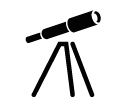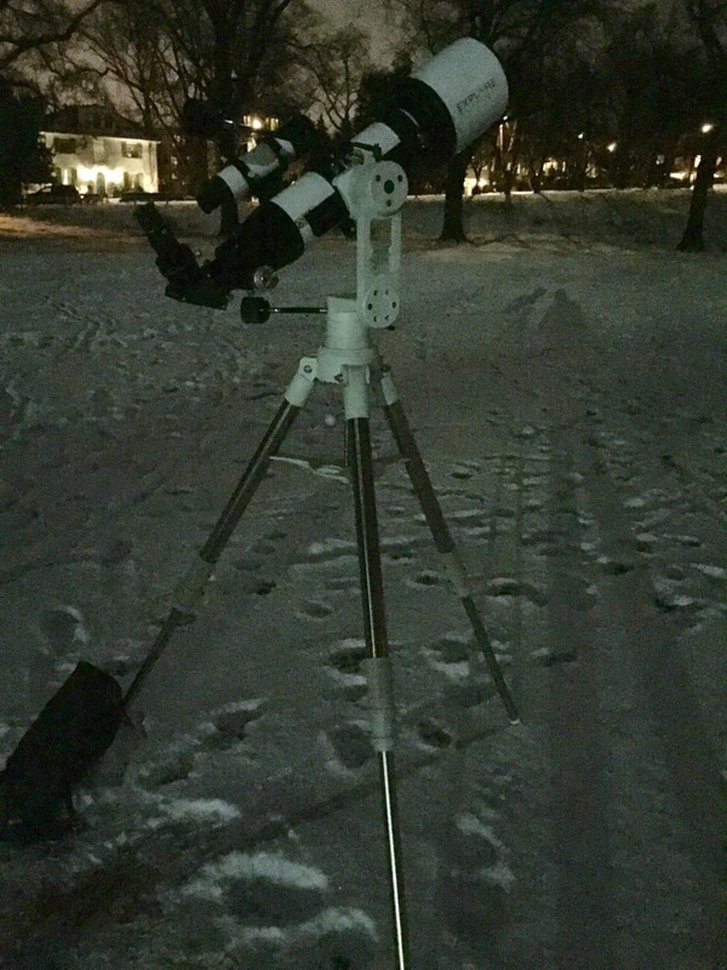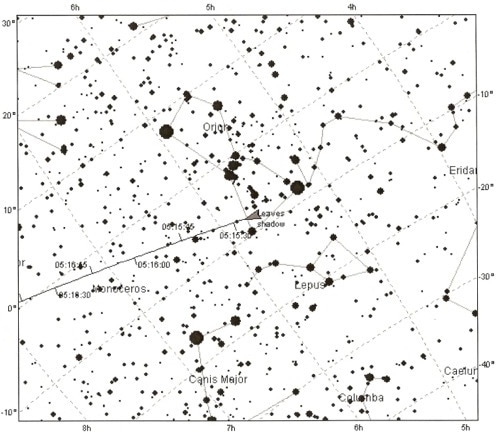|
I received my Twilight I mount yesterday, and my 4-inch, AR 102 refractor arrived a few days earlier. It snowed in the afternoon, but cleared up around sunset. At the same time, I scouted a new observing site, in the park just east of Sidwell Friends School. Bright lights from the school illuminate part of the park, but it's better than my usual observing site. Despite the bitter cold, I decided to pack my telescope and give it a go.
By the time I arrived at the park, it was only a few minutes to 9:00 PM. Mars and especially Venus were low on the horizon, glittering behind a tangle of trees. I spotted Mars through my finderscope, but I'm not sure if I ever had it in my telescope's field of view. It's awfully far from Earth right now and its apparent size to observers from Earth is tiny (just over 5 arc seconds). I used a 15 mm eyepiece, so the magnification through my telescope (which has a focal length of 663 mm) was only around 44x. Barely enough to make out a disk. The half moon was high in the sky - almost at zenith! - and of course it was a much easier target. I could now fiddle with the finderscope to align it with my telescope. I used a 33 mm eyepiece, so my magnification barely reached 21x. I could comfortably fit the whole moon into my view. It was almost painfully brilliant, but utterly breathtaking. The detail was incredible, and I could scarcely make out any chromatic abberation (an optical distortion common to achromatic refractors). By now, my telescope had cooled down to match the temperature of the air, so the image was crisp. It struck me that the optical quality of the telescope seemed higher than that of any other telescope I've used before. It's not a long list, but still: I was impressed. Orion was high in the sky, too, so I trained my telesope on my real target in tonight's skygazing: the Orion Nebula. At 44x, I could easily make out the Trapezium Cluster: four enormous stars at the heart of the nebula that may be moving around a huge black hole. The stars were glittering pinpoints. I could see obvious nebulosity, too, but there wasn't much detail amid the glare of the moon and the city lights. I screwed an Orion ultrablock narrowband filter into my eyepiece and had another look. The filter only lets in light that shines at the wavelengths of emission nebulae, such as the Orion Nebula. This time, the Trapezium was harder to discern. Yet by using averted vision - by using my peripheral vision, and thereby activating the light-sensitve rods in my eyes - I clearly made out two wings of boiling green gas. It was breathtaking. For a moment, I forgot how cold I was. Lastly, I added a barlow lens (doubling my magnification), screwed in a yellow filter, and turned back to the moon. At 88x, the detail on the lunar surface was spellbinding. I nearly lost myself tracing subtle shadings in the lunar "seas." Yet when the Northwest breeze picked up and the windchill dipped to -15°C, I realized it was time to go. With numb and borderline frostbitten fingers, I packed up my icy telescope. All in all, a great (but frigid) observing session. The AR 102 impressed me, as it has many other amateur astronomers. The telescope cooled quickly and afforded some remarkably crisp views that were a definite step up over my similarly-sized Celestron (which I'll now move to Winnipeg, where I often stay over the summer). The mount, focuser, and diagonal were also all superb. The straight through finderscope is predictably hard to use, however. It looks great, but I'll probably replace it either with a red dot or right angle correct image finder. Still, not a big deal. I also used a nebula filter for the first time, and enjoyed learning about its advantages and limitations. Moreover, I used averted vision more effectively than I ever have before. The yellow filter was a first for me, too. It helped me pick out some fresh details on the moon, but the false color was a little distracting. Perhaps I'll use a dedicated lunar filter next time. And most importantly: I observed a deep space object (DSO) from a big city for the first time. The didn't measure up to what I've seen with a similarly-sized telescope (a 6-inch reflector) in the countryside, but still: I was blown away by what I could make out. One thing I'll definitely need: a foldable camping chair or stool. Kneeling in the snow doesn't cut it.
1 Comment
|
Archives
March 2024
Categories
All
|




 RSS Feed
RSS Feed